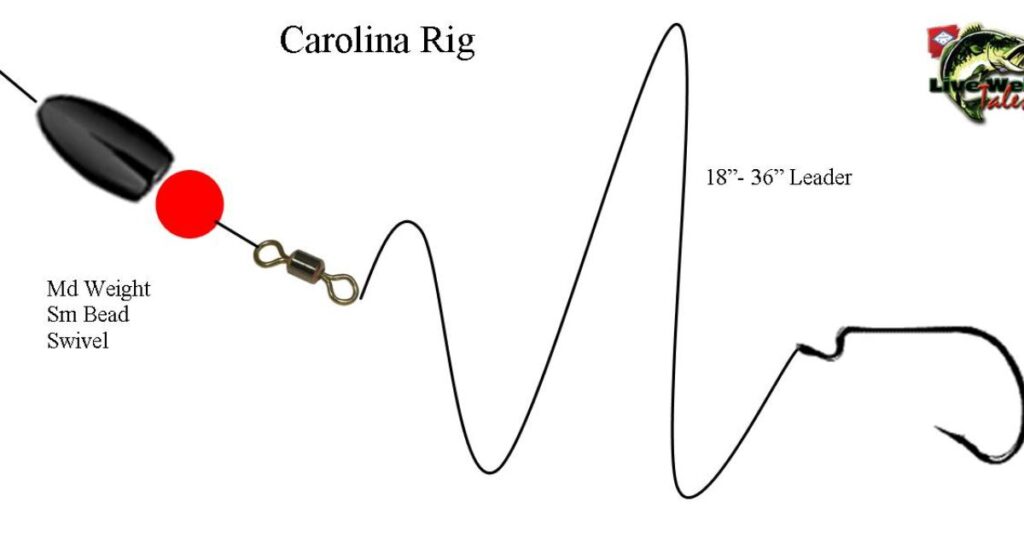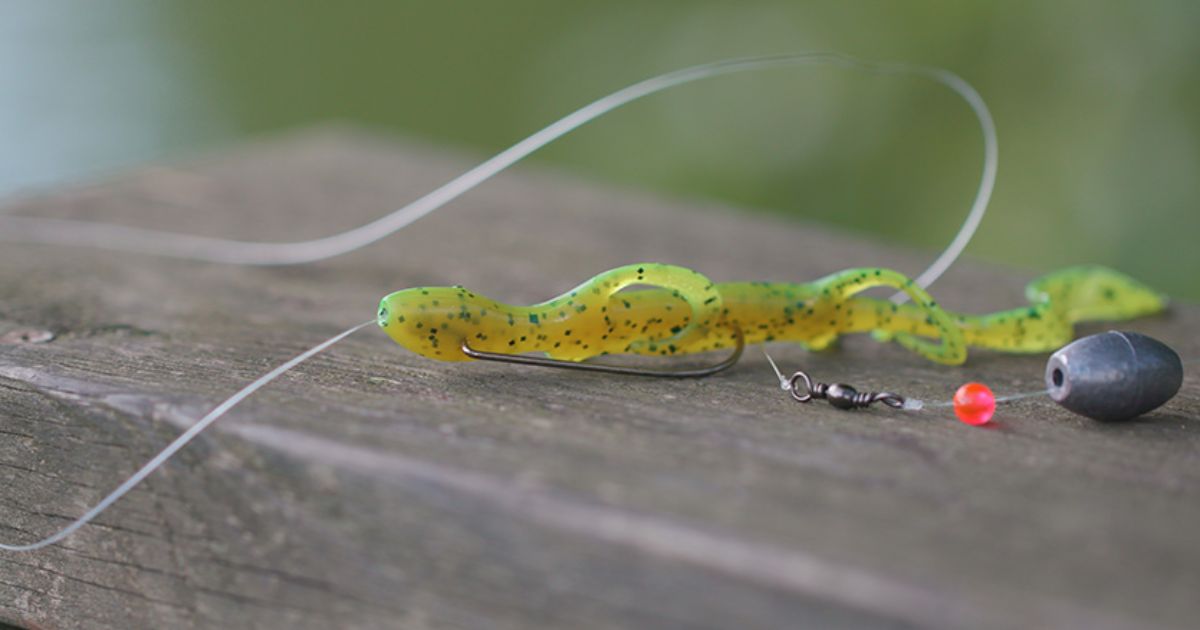Bass fishing is a sport that requires a combination of skill, strategy, and patience. One effective technique for catching bass, especially in challenging conditions, is the Carolina rig. In this comprehensive guide, we will dive deep into the world of Carolina rig fishing for bass. We’ll cover everything you need to know, from defining what a Carolina rig is to step-by-step instructions on how to fish it successfully. By the end of this article, you’ll be well-equipped to tackle bass with confidence using this proven method.
What is a Carolina Rig?
Before we delve into the details of how to fish a Carolina rig for bass, let’s start by defining what a Carolina rig is. A Carolina rig is a versatile and effective bass fishing technique. It is a specialized rig consisting of a few essential components.
Main Line The main line is usually a sturdy monofilament or braided line that connects your rod and reel to the rest of the rig.
Bullet Weight A bullet-shaped weight, often made of lead, is threaded onto the main line. The weight helps the rig sink and stay close to the bottom, where bass often lurk.
Beads Small plastic or glass beads are placed above the weight. They serve to protect the knot connecting the weight and swivel, reducing friction that can weaken the line.
Swivel A swivel is attached to the main line below the beads. This component prevents the weight from sliding all the way down to the hook and tangling the rig.
Leader Line The leader line is usually a lighter monofilament or fluorocarbon line that connects the swivel to the hook.
Hook The hook is the most critical part of the rig. It’s where your bait or lure is attached, and where you’ll ultimately hook the bass.
Now that we’ve defined the Carolina rig, let’s explore the steps to fish it successfully for bass.
How to Fish a Carolina Rig For Bass
Master the Carolina Rig for bass fishing. This versatile technique combines a weight, bead, swivel, leader, and soft plastic lure for a stealthy approach. Learn how to rig, cast, and retrieve, ensuring you’ll hook more bass with this proven method.
Selecting the Right Equipment
Before you hit the water with your Carolina rig, it’s essential to make sure you have the right equipment. The right equipment will help you cast accurately and handle bass efficiently.
Rod and Reel Choose a medium-heavy to heavy-action rod with a fast or extra-fast tip. Pair it with a baitcasting reel that can handle heavier line and is suitable for bass fishing.
Line For your main line, opt for 12 to 20-pound test monofilament or braided line. For the leader line, go for 10 to 15-pound test fluorocarbon or monofilament. The main line should be stronger to handle the weight and control the bass, while the leader line is more subtle for finesse.
Hooks Carolina rigs are typically used with offset hooks or worm hooks. Select the appropriate size, depending on the bait you plan to use. A 3/0 or 4/0 hook is a good starting point for most bass fishing scenarios.
Bait Carolina rigs are compatible with a wide range of soft plastics, such as plastic worms, creature baits, lizards, or crawfish imitations. Choose your bait based on local bass preferences and water conditions.
Assembling the Rig
Assembling the rig is the crucial first step in any angler’s journey. It involves selecting the right rod, reel, line, and tackle for your target species and conditions. A well-assembled rig sets the foundation for a successful and enjoyable fishing adventure. Now that you have the right equipment, it’s time to assemble your Carolina rig.
Thread the Bullet Weight Slide the bullet weight onto your main line. The pointy end should go first. The weight should be heavy enough to maintain contact with the bottom but not so heavy that it gets stuck in the rocks or vegetation.
Add Beads Place a few beads on the main line above the weight. These beads act as a buffer between the weight and the swivel.
Attach the Swivel Tie the swivel to the end of the main line using a secure knot like the Palomar knot.
Tie the Leader Line To the other end of the swivel, attach the leader line using a strong knot, such as the improved clinch knot or loop knot.
Attach the Hook Finally, tie your chosen hook to the other end of the leader line. Make sure it’s securely fastened, as this is where you’ll be hooking the bass.
Choosing the Right Spot
Location is crucial in bass fishing. Bass are known to inhabit various underwater structures, so identifying the right spot is essential. Look for areas with submerged vegetation, rocky structures, points, drop-offs, and ledges. These are often prime locations for bass.
A Carolina rig is particularly effective in deeper waters or when bass are holding close to the bottom. Use a depth finder or your knowledge of the water body to determine the ideal spot.
Casting and Retrieving
Casting and retrieving are fundamental angling skills. Casting involves accurately propelling the bait or lure into the water, while retrieval entails reeling it in. The technique, speed, and presentation can vary depending on the target species and fishing conditions, making it a crucial aspect of successful fishing. Once you’re in the right spot, it’s time to cast your Carolina rig. Here’s how to do it effectively.
Cast Out Make a long and accurate cast to the target area. Allow the rig to sink to the bottom. Keep your line slack to let the rig settle.
Maintain Contact After the rig has settled, it’s crucial to maintain contact with the weight. You should feel the weight dragging on the bottom as you slowly reel in the slack line.
Retrieve Slowly Start a slow, steady retrieve, maintaining a slight bow in your line. This keeps the bait above the weight, making it look like an easy meal for bass.
Feel for Strikes Be attentive to the line and any subtle changes in pressure. Bass may bite softly, so pay attention to any unusual sensations in your line, such as a slight tap or a sudden resistance.
Setting the Hook
Setting the hook is a crucial skill in fishing. It’s the precise moment when you pull your rod to secure a fish that’s taken your bait. Timing and technique are key to ensure a successful catch, making it a fundamental aspect of angling expertise. When you feel a bite or notice any unusual behavior in your line, it’s time to set the hook.
Reel in Slack Quickly reel in any slack to maintain tension on the line.
Make a Firm Hookset With a Carolina rig, it’s often best to set the hook with a sweeping or sideways motion rather than a vertical one. This helps ensure a solid hookset.
Play the Fish Once you’ve set the hook, be prepared for a battle. Bass can put up a fight, so use your rod and reel to play the fish, keeping tension on the line, and gradually bringing it to the surface.
Landing the Bass
Landing a bass successfully is the last step in the process. Be sure to use a landing net if you’re in a boat or carefully reel the bass to the shoreline if you’re fishing from the bank. Practice catch and release to help preserve bass populations for future generations.
Key Components of a Carolina Rig

| Component | Purpose |
| Main Line | Connects the rig to the rod and reel. |
| Bullet Weight | Adds weight for casting and keeping the rig down. |
| Beads | Protect the knot and reduce friction. |
| Swivel | Prevents the weight from sliding to the hook. |
| Leader Line | Connects the swivel to the hook. |
| Hook | Where bait or lure is attached and bass are hooked. |
FAQs
What type of bait works best with a Carolina rig for bass fishing?
Soft plastics are the most commonly used bait with a Carolina rig. Popular options include plastic worms, creature baits, lizards, and crawfish imitations. Choose your bait based on local bass preferences and water conditions.
Can I use a Carolina rig in shallow water?
While Carolina rigs are most effective in deeper waters, you can use them in shallower areas by adjusting the length of your leader line. Shorten the leader to keep your bait closer to the surface.
What is the best time of day to fish a Carolina rig for bass?
Bass are more active during low-light periods, such as dawn and dusk. However, they can be caught throughout the day. Pay attention to the local conditions and adjust your fishing schedule accordingly.
Are there any variations of the Carolina rig for different situations?
Yes, there are variations like the Texas rig, which eliminates the swivel and uses a bullet weight directly above the hook. The Texas rig is excellent for fishing in heavy cover.
Is catch and release important in bass fishing?
Yes, catch and release is essential for the conservation of bass populations. It ensures that bass have the opportunity to reproduce and maintain healthy numbers in the ecosystem.
Conclusion
Carolina rig fishing for bass is a versatile and highly effective method for catching these elusive freshwater giants. By selecting the right equipment, assembling the rig correctly, choosing the perfect spot, casting and retrieving with precision, and setting the hook with confidence, you can significantly increase your chances of success.
Keep in mind that bass fishing is not just about catching fish it’s also about enjoying the outdoors and respecting nature. Always practice responsible angling and conservation to ensure the sustainability of this fantastic sport.

